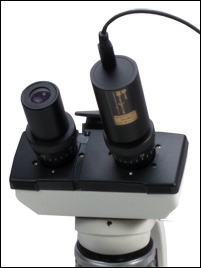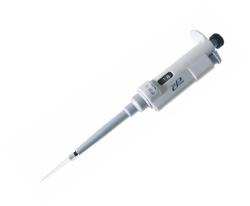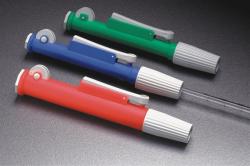Gear list
A gear list for counting cells might look like this. There's any number of options and there's often barely a ceiling on the price you can pay for each item. However, broadly,
the higher prices offer greater accuracy and high-use/specific-use functionality; most of which is wasted on a cell counting exercise. We're doing a handful of counts a day and more interested
in precision than accuracy.
I've built this list with price foremost in mind, but also precision. In addition to the list, I've provided some colour on the purpose of each component.
This is only guidance and you must consider your specific needs and seek advice where necessary.
The following guidance ranges from the "cheap and cheerful" Option A to the high precision and ease of use of Option C. All three should provide acceptable results for brewing, distilling or wine making.
The minimum hardware requirements for CellMate:
- computer w/ Windows, OSX or Linux; one available USB port (faster processor ~= faster results)
- microscope - Cellmate will only work with a brightfield microscope w/ 40x objective - this is the common microscope spec
- microscope camera - Cellmate is only tested with the camera specified, below.
- standard haemocytometer counting chamber
|
Price (GBP, inc VAT) |
|
| Item |
Option A |
Option B |
Option C |
Shop |
| Microscope (min. 400X) |
127.00 |
220.00 |
290.00 |
Apex Microscopes |
| Camera |
138.00 |
138.00 |
138.00 |
Brunel Microscopes |
| Pump Pipette Filler (25mL) |
30.43 |
|
|
Camlab |
| 2x Serological Graduated Pipette (25mL) |
15.26 |
|
|
Camlab |
| Pump Pipette Filler (10mL) |
|
22.88 |
|
Camlab |
| 2x Serological Graduated Pipette (10mL) |
|
8.18 |
|
Camlab |
| Pump Pipette Filler (0.2mL) |
24.61 |
|
|
Camlab |
| 2x Serological Graduated Pipette (1.0mL) |
6.43 |
|
|
Camlab |
| Disposable Pastuer Pipettes |
4.79 |
|
|
Camlab |
| Adjustable-Volume Pipette (0.5-5mL) |
|
|
148.80 |
Cole-Parmer |
| Adjustable-Volume Pipette (20-200μL) |
|
176.40 |
176.40 |
Cole-Parmer |
| Cytometer & 2x Cover Glasses |
60.83 |
60.83 |
60.83 |
Camlab |
| 10x Spare Cover Glasses |
|
14.40 |
14.40 |
Camlab |
| Methylene Blue Dye (5g) |
6.78 |
6.78 |
6.78 |
Camlab |
| 500x 1.5ml Graduated Microtubes |
10.84 |
10.84 |
10.84 |
Camlab |
| TOTAL |
424.97 |
658.31 |
846.05 |
|
| TOTAL (ex. VAT) |
354.14 |
548.59 |
705.04 |
|
(Prices as at 5th November 2018)
Microscope

Cell counting isn't especially demanding on microscope hardware. A usable image can be achieved on inexpensive hobby microscopes. I've worked with my local microscope company and concluded that
those linked to above are suitable. Without wanting to get too technical, the necessary features are: 10x & 40x objectives; mechanical stage (not clip in); and a substage condensor - it's
a sort of lens-construction between the light source and the stage.
These suggested microscopes offer a bright, consistent image and a much higher build quality than that of the hobby microscope I started with; in the sub-£100 price band.
CellMate is compatible only with brightfield microscopy. Phase contrast and darkfield are not yet catered for.
Camera
There's an increasingly wide range of microscope cameras. At present, CellMate is only compatible with the camera specified above. However, in principle any "plug & play" USB
of sufficient quality and with the necessary field of vision should work. Note that many more expensive cameras are not plug and play and not compatible. CellMate does provide the option
to import an image from the computer.
Liquid Handling
There are two popular solutions for moving small, precisely measured volumes of liquid. At low cost, serological graduated pipettes and pumps provide a good level of potential accuracy, however this is
dependent on the operator, who controls exactly how much liquid is pumped in and out. At the higher end, micropipettes are similar in principle, but offer excellent accuracy & repeatability (see below)
for measures as small as 10μL (0.01mL) with less reliance on a careful operator.
Ultimately, we're trying to achieve consistent dilutions to bring slurries with billions of cells down to a level where we (and the computer) can feasibly count a sample. Typically, a yeast
slurry collected from a beer fermentation will need to diluted upto 1000x; less so for the computer.
Micropipettors

Using the micropipettors suggested in Option C, above, a 500x dilution can very easily and quickly be achieved by pipetting 20μL of the yeast slurry
and 10mL (5mL twice) of dilutant (ie. water). Then, by pipetting equal measures (ie. 200μL) of the first dilution and viability dye, we reach our 1000x dilution.
A micropipette will come with a few tips, which are reusable, though prices for large quantities makes them potentially disposable, if you prefer.
More...
These micropipettes may account for a significant amount of our cell counting investment and warrant a closer look at the precision they offer.
| Micropipette |
Type |
Min (μL) |
Max (μL) |
Inaccuracy (%) |
Imprecision* (%) |
Price (inc VAT) |
Datasheet |
| Cole-Parmer (WZ-21600-20) |
Adjustable |
500 |
|
6.0 |
2.0 |
148.80 |
Cole-Parmer |
|
|
|
5000 |
0.6 |
0.2 |
|
|
| Socorex Acura® 825 |
Adjustable |
20 |
|
1.5 |
0.6 |
213.60 |
Socorex |
|
|
|
200 |
0.6 |
0.2 |
|
|
| Brand Transferpette® S Digital D-200 IVD |
Adjustable |
20 |
|
3 |
0.6 |
210.55 |
Brand |
|
|
|
200 |
0.6 |
0.2 |
|
|
| Cole-Parmer (GY-21600-68) |
Adjustable |
20 |
|
1.5 |
0.2 |
176.40 |
Cole-Parmer |
|
|
|
200 |
0.6 |
0.3 |
|
|
| Brand Transferpette® S |
Fixed |
20 |
20 |
0.8 |
0.4 |
123.01 |
Brand |
| Socorex® Acura® 815 |
Fixed |
20 |
20 |
0.7 |
0.5 |
131.64 |
Socorex |
| Cole-Parmer (WZ-21600-02) |
Fixed |
200 |
200 |
0.3 |
0.2 |
92.40 |
Cole-Parmer |
* Coefficient of Variation (CV, %)
The first thing to note is that adjustable volume models offer significantly less accuracy at their lower volume bounds. However, our principle aim in liquid handling for cell
counting is to ensure our dilutions are the same week in, week out. This repeatability is also known as "Imprecision" (and statistically as Coefficient of Variation (CV)).
Personally, I own the Cole-Parmer (CP) 0.5-5mL, CP 200μL & Socorex 20μL (CP don't currently produce a fixed volume 20μL). The build quality of the Socorex feels significantly better, but,
for now, I can only conclude that CP's precision and price make these superior, on balance, for cell counters.
Serological Pipettes

Serological pipettes are long, thin glass stems to which a pump is attached. By virtue of that long, thin shape the operator can clearly and accurately determine how much liquid has been
drawn (or dispensed from the drawn amount). Graduations on a 1ml pipette are at 10μL (0.01mL) and can be accurate to +/-0.007%. They're also useful for sucking samples out from specific points of
a sample or vessel.
The negative aspect of the long pipette shape is that it is slightly more fiddly to use, but, as with most things, that comes with practice. It is glass and it is delicate; hence
they are often sold in pairs. Finally, each pipette type (1/5/10/25mL) is paired with a pump ensuring the operator has a fair chance of making accurate adjustments. Although the
1mL pipette fits, for example, the 10mL pump, I can assure you that making small adjustments is challenging.
Using one, the other, or a combination of serological and micro-pipettes, we can achieve our dilutions.
Disposable Pastuer Pipettes
This type of pipette allows us to transfer small volumes from small or narrow-access vessels and place them carefully on, for example, a cytometer. They aren't much designed for accuracy
and precision.
(Haemo)cytometer & Cover Glasses
The cytometer gives us a fixed set of squares forming a grid, including fixed depth. By counting the cells in a good sample of these fixed-volume squares, we're able extrapolate to calculate how many
cells we expect in our undiluted sample or slurry. There is varying quality (accuracy of the grid), but agreeable accuracy for brewing is entirely achievable for ~GBP60, as above. Additionally,
there is a choice of "standard" and "metallised". This refers to the material with which the grid is printed. Metallised cytometers show white lines, which some manual counters prefer over
dark lines. However, Cellmate is designed for standard cytometers.
A pair of cover glasses are often supplied with a cytometer, but in a busy environment, it's very possible to lose or break cover glasses, particularly during cleaning. If you can't ensure careful handling,
have spares on hand. Also, be aware that cover glasses for cytometry are a distinct type - being heavier, they hold the sample in place . Non-cytometer specific cover glasses will affect counting accuracy.
Viability Dyes
There's a choice of a few dyes and minor variations on each. Methylene Blue (aka. Methylthioninium Chloride) is the most popular, but I understand Erythrosine B is more reliable and non-toxic.
The manufacturer or supplier should provide instruction to dilute, if necessary; it can be obtained in a pre-diluted format.
Microtubes
These very small vessels make it easier to shake our sample manually or by way of some invention. My multi-tool and a makeshift attachment work well. This ensures that the
cells are distributed evenly within our sample and that clumps of cells are broken up enough to count.


